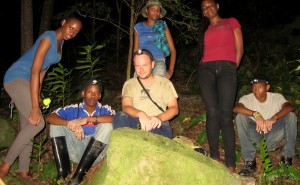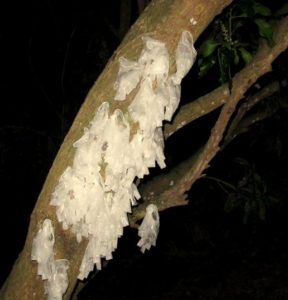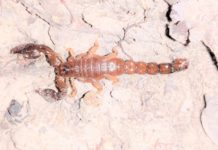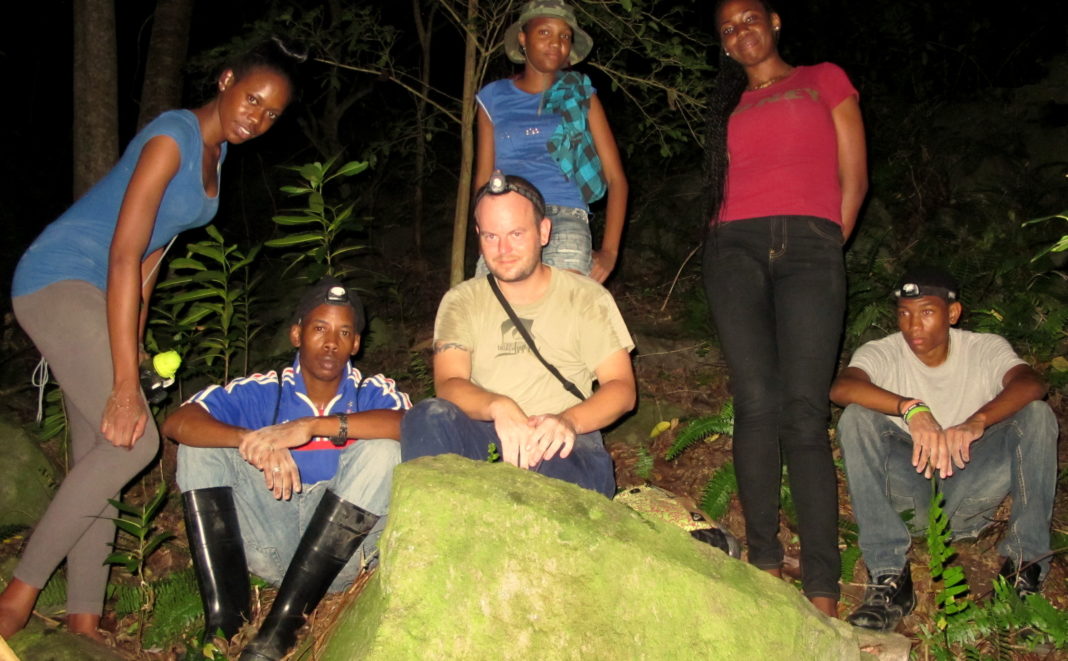Machel Sulton from the Dominica Mountain Chicken Team lets us in on the nights out spent catching treefrogs for the project.
The impact of climate change is evident as this year’s weather pattern has been a strange one for most Caribbean countries, with Dominica being no exception. It has been relatively hot, dry and humid but this is no excuse for the Mountain Chicken team not to be out carrying out tree frog surveys. These are little frogs that you will sometimes find in your kitchen, bathroom or around your home are the tree frogs, and locally they are known as “gounouj”. During the survey, the target is set at finding sixty (60) of these frogs at each site each night of field activities. Team members are out three (3) nights a week, back-to-back, returning home tired from long hours of frogging, and with sore leg muscles – the result of climbing up steep terrain at our most difficult site. But we all endured in the end.

The two confirmed species of tree frogs present on Dominica are the Dominican “Gounouj” (Eleutherodactylus amplinympha), and the tink frog (Eleutherodactylus martinicensis) – the species that most Dominicans are familiar with. There is a possibility that the Johnstone’s whistling frog (Eleutherodactylus johnstonei) may also be present but has not be confirmed. It is important to conduct such surveys so that scientists can have an idea of the level of Chytrid present in particular areas. Over the years, i.e. since Chytrid was discovered, it has been noticed that these small frogs are not affected, they do not die from the disease, and they act as a reservoir for the Chytrid fungus.
Two (2) of the survey sites are located in the low-lying forest of Dominica and the third leads to the steep, lush forest in the south of the island. Each of the sites selected is habitat of known surviving mountain chicken frogs. We can testify that each individual site brings about a different challenge, different surroundings and occasionally harder to find the tree frogs, which can be something frustrating. Sometimes, the frogs can be heard calling all around you, or even in front of you, and yet you would have your work cut out for you in terms of spotting them, as they are so tiny (about to 3-10mm) and so well camouflaged. Even then once you have them spotted you still need lightening reactions to be able to successfully capture the frog!

When conducting this survey we carry along a fieldwork backpack, data-collection sheets, clip board, a pen/pencil, 2-3 boxes of non-powdered gloves, head-torches, and spare batteries for head-torches, a stapling gun, a garbage bag and swabs. Each frog that is caught is swabbed to test for the presence of Chytrid, and then kept in that glove until the survey is ended to ensure that the same one frog is not processed twice. The glove is then stapled temporarily to a tree. Upon completion of the survey activity for the night, every frog safely is released back into the wild.
Despite the challenges that the tree frog survey poses, the team leaves the field with a light heart, after turning the night into a fun-filled exercise. Competition among team members to catch the most frogs, count-down timing, sharing jokes and motivational speeches are tools we use to keep the spirit/drive going until we catch the set target of frogs.







